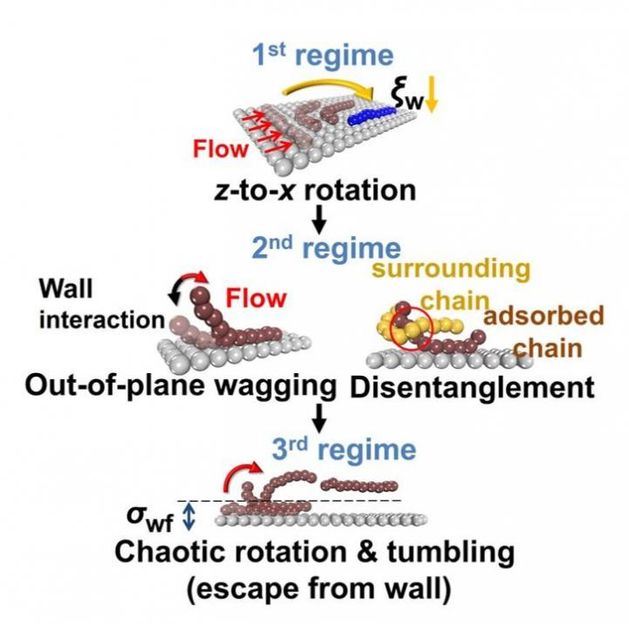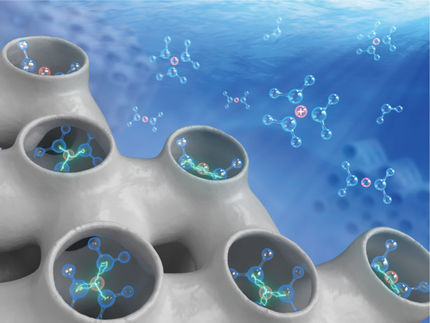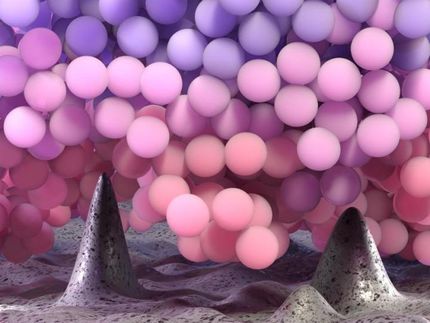Identification of molecular origins underlying the interfacial slip
A team of researchers, affiliated with UNIST has discovered the fundamental principles of handling polymers, which constitute the basis of man-made materials, such as plastics, paints, and even consmatics.

The schematic description of the main molecular mechanisms and dynamics directly related with the interfacial slip for each of the three regimes.
UNIST
In this work, Professor Chunggi Baig of Energy and Chemical Engineering and his team presented, for the first time, the detailed molecular mechanisms and dynamics underlying slip phenomena, which have yet to be established in interfacial polymer rheology.
They presented the intrinsic molecular characteristics of the slip phenomena by using atomistic nonequilibrium molecular dynamics simulations of polyethylene melts under shear flow. Polymer melts are polymers with an overall number average molecular weight of 10,000 in the liquid-like melt state without solvent.
This interfacial slip phenomena, which occurs at the interface with other objects, has been pointed out as the major cause of melt instability, which degrades the quality of plastics. Therefore, in a system that has interface, such as biomembranes and polymer thin films, the interfacial slip phenomena is definitely one of the most important variables for determining the properties of polymeric materials.
Therefore, in-depth information of molecular mechanisms and dynamics behind, such interfacial properties is essential for producing high-quality plastics, as well as for predicting and controling intriguing behaviors of various confined systems.
"One example of this interfacial slip phenomenon is when the polymer melts slip at the mold boundary and causes surface roughness or cracking," says Sohdam Jeong of Energy and Chemical Engineering at UNIST, the first author of the study. "Through this study, I wanted to solve the fundamental principles of this slip phenomena on a molecular level."
In their efforts to reveal the molecular origins underlying the interfacial slip, the research team analyzed the slip phenomena in detail, with respect to molecular mechanisms and dynamics of interfacial chains and their rheological characteristics by directly tracking down the individual chain motion near the interface.
In the study, the research team identified three distinctive characteristic regimes with regard to the degree of slip at the interface and revealed the underlying molecular mechanisms for each regime: (i) the z-to-x chain rotation mechanism in the vorticity plane in the weak flow regime, which effectively diminishes the wall friction against chain movement along the flow direction, (ii) the repetitive chain detachment-attachment (out-of-plane wagging) and disentanglement mechanism in the intermediate regime, and (iii) irregular (chaotic) chain rotation and tumbling mechanisms in the strong flow regime.
"Depending on the types of polymeric materials and the boundary structure of the interface, the interface slip might be slightly different," says Sohdam.
"The findings of this study help us comprehend the fundamental characteristics of the interfacial slip, and understand various rheological phenomena and properties exhibited by interfacial polymeric systems," says Professor Baig.
Original publication
Sohdam Jeong, et al.; "Molecular mechanisms of interfacial slip for polymer melts under shear flow"; Journal of Rheology; 2017.
Original publication
Sohdam Jeong, et al.; "Molecular mechanisms of interfacial slip for polymer melts under shear flow"; Journal of Rheology; 2017.
Organizations
Other news from the department science
These products might interest you

Eclipse by Wyatt Technology
FFF-MALS system for separation and characterization of macromolecules and nanoparticles
The latest and most innovative FFF system designed for highest usability, robustness and data quality

Spinsolve Benchtop NMR by Magritek
Spinsolve Benchtop NMR
Spinsolve is a revolutionary multinuclear NMR spectrometer that provides the best performance

HYPERION II by Bruker
FT-IR and IR laser imaging (QCL) microscope for research and development
Analyze macroscopic samples with microscopic resolution (5 µm) in seconds

Get the chemical industry in your inbox
By submitting this form you agree that LUMITOS AG will send you the newsletter(s) selected above by email. Your data will not be passed on to third parties. Your data will be stored and processed in accordance with our data protection regulations. LUMITOS may contact you by email for the purpose of advertising or market and opinion surveys. You can revoke your consent at any time without giving reasons to LUMITOS AG, Ernst-Augustin-Str. 2, 12489 Berlin, Germany or by e-mail at revoke@lumitos.com with effect for the future. In addition, each email contains a link to unsubscribe from the corresponding newsletter.





























































